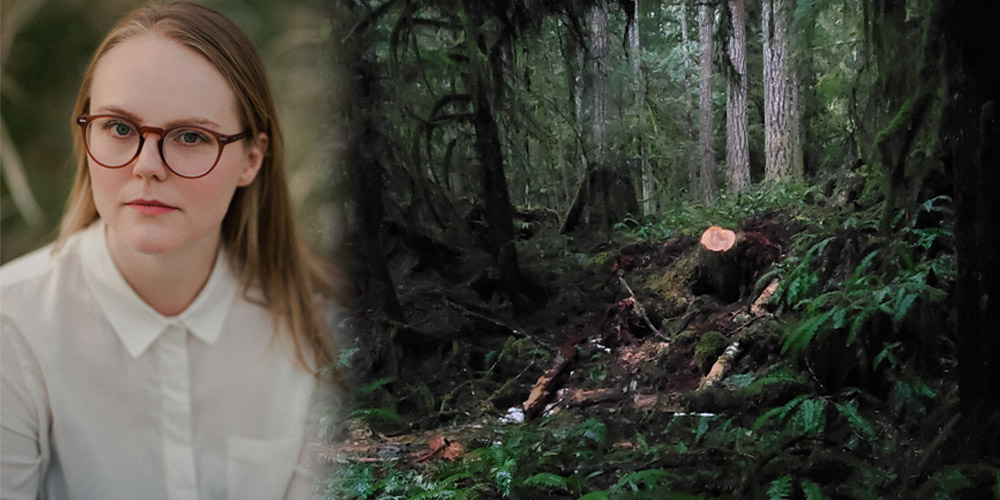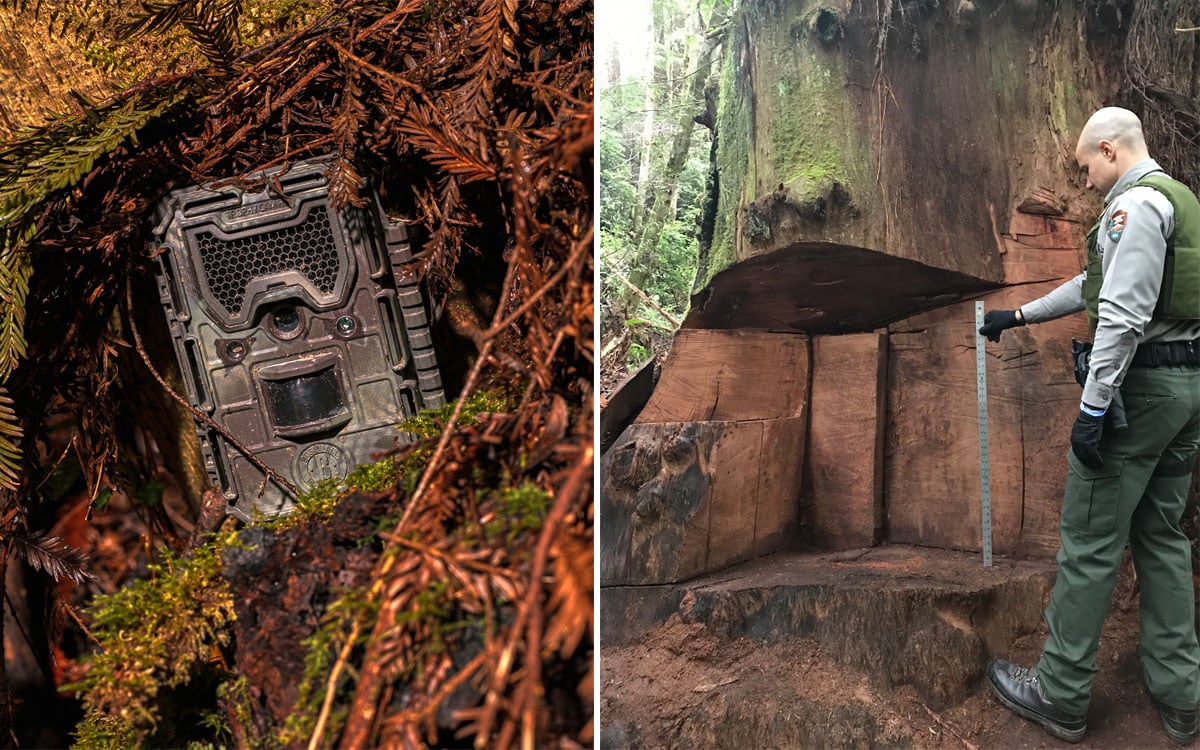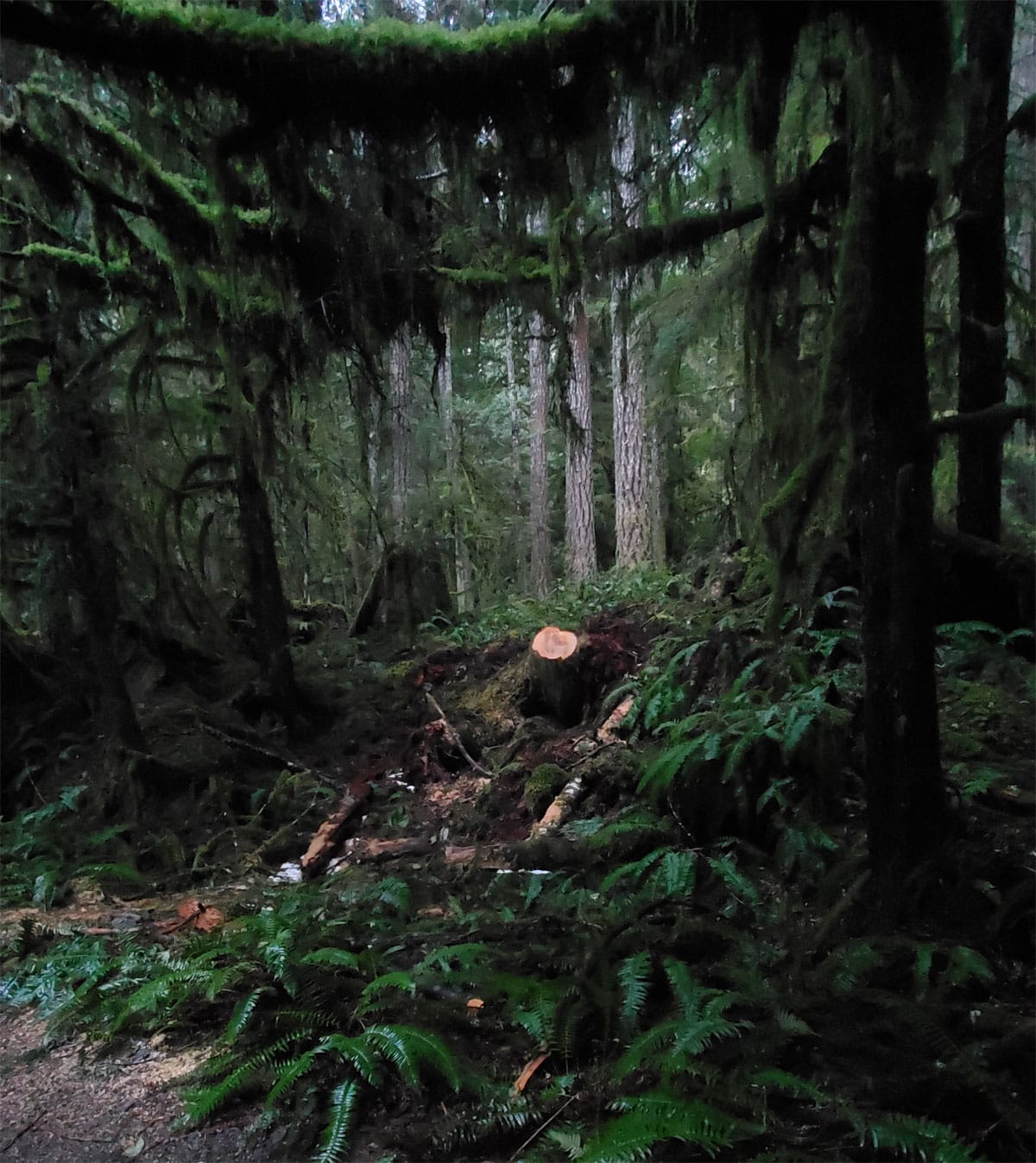
“You use a chainsaw,” says Lyndsie Bourgon. “In some cases, you might use an axe.”
The only difference in method between stealing a tree and cutting down one legally, she explains, is that poaching takes place at night.
Bourgon, the author of Tree Thieves: Crime and Survival in North America’s Woods, spent years investigating the economy and ecology of unlawful logging, from furtive fir-snatchers who unload their illicit lumber on Facebook Marketplace and Craigslist, to the rangers in the U.S. and Canada tasked with hunting them down.
In Northern California’s Redwood National Park, authorities have even taken to studding the forest with night-vision-equipped, motion-activated surveillance cameras as deterrents.
On this week’s CANADALAND, the B.C.-based Bourgon speaks to host Jesse Brown about the arboreal underworld of black-market timber:
The following is an edited excerpt from their conversation, pushing past pruning puns to arrive at some thornier truths…
JESSE BROWN: Who are the people who poach trees?
Lyndsie Bourgon: This is what I set out to figure out. I’d read a story about tree poaching, and in the beginning, I thought, “This is gonna be a good narrative. It’s gonna be like a law-enforcement investigation story. The victim is very compelling, because the victim is a tree.”
Because everybody loves trees. So a tree thief, that’s a great villain. That’s a good bad guy.
Yeah! And then, very slowly, over the course of many years, my narrative just completely unravelled and turned into something new.
What do you mean?
Well, first of all, I started doing interviews with those park rangers, who started telling me about who they saw doing the poaching and who they were fining and charging. And I also started really digging into the history of poaching. And there were a lot of very strong parallels between the history of poaching, as a kind of ancient folk practice and tradition, and the people that are doing it today.
When I was talking with investigators, and then social workers, in some of the areas in which this poaching was taking place, we really were getting into issues of unemployment and rural degradation — a decline in economy and also a decline of community, and what that meant for the people that lived in a lot of the small towns in these former logging regions of British Columbia and Washington State, Oregon, Northern California. And how all of these compounding factors of the last 30 to 40 years, in terms of what has gone in there in the economy, have really created a crisis of unemployment and disaffection.
Are these guys laid-off loggers?
I would say that they tended to be the sons and grandsons of former loggers. I ended up actually doing quite a few long family-history interviews with the poachers that I spent time with. For much of the book, I was centred in a town called Orick, California, which is where this redwood poaching is happening. But I heard echoes of Orick’s experience up and down the coast. Here’s a town that was built up around mills and logging in the early-to-mid-20th century. During that time, logging went through booms and busts, as it always had, but at the same time, technology was progressing to the pace where clearcut logging was increasingly becoming the method of logging. And so not only was there logging happening, but it was happening at a speed that was completely unsustainable.
“In the 1980s and 1990s, the rhetoric around loggers was really quite insulting. It relied on stereotypes against the working poor, rather than focusing on corporate malpractice or greed.”
Once that industry bottomed out, it ended up leaving a lot of people unemployed and feeling very dejected, feeling very angry. When all the dust settled, many folks and their families were left behind in towns that no longer had the kind of tax base that it needed. It no longer had the industry that was funding a lot of the services that were required. And because so much environmentalism was also happening at this time, there was a lot of conflating of the reasons as to why this had happened: it became very common to blame the National Park Service or provincial parks or national parks for the decline of industry and the decline of a town and a lifestyle, essentially. The minute I sat down with poachers and started asking them about “why do you poach” or, you know, “what’s the motivation here,” it was always going back to the experience of their fathers and their grandfathers and how something had been taken away with that work.
I’m picturing the forgotten workers of industrialization and thinking of people who once had steady labour, and then industry leaves but they’re still there. Meanwhile, there’s a lot of activism and environmentalism that’s directed at the logging industry. And then these are the guys caught in between.
The logging industry has done a really good job of, essentially, trying to displace the criticism lobbed towards them onto the workers. And that works for them, because it makes workers really upset. Nobody wants to hear that everyone thinks that your work is pointless and that you’re causing damage. In the time of the War in the Woods and the Clayoquot Sound protests in B.C. and the Timber Wars in the United States of the 1980s and the 1990s, the rhetoric around loggers was really quite insulting. It relied on stereotypes against the working poor. And so rather than focusing on corporate malpractice or corporate greed, it was very quickly put against loggers themselves. There were editorial cartoons saying that they were, like, raping the planet and comparing them to Leatherface from The Texas Chainsaw Massacre. And that really hurt a lot of people, and left a legacy of resentment and anger toward the system.

Is there like an outlaw spirit to this?
Oh yeah. The history of poaching is just fascinating, and partly that’s because it’s really a working-class crime. You know, the conceit is that poaching is essentially hunting or logging or fishing — and then one day a boundary is put up that says, “No, you can’t do that there anymore.” And then it’s a crime. And so many of the loggers that I spoke to, we talked about Robin Hood a lot. This was a big guiding justification for what they do. I think a lot of people would disagree, and I understand that. But the kind of narrative around it is interesting in itself.
Robin Hood was seen as taking from the rich, giving to the poor. In historical records from the 16th, 17th century or so, you can read about, in England in particular, poachers being tried in special forest courts for taking trees from land that was once common land that had then been sequestered for the use of the monarchy and the aristocracy and the wealthy. All of a sudden, those people were not allowed to go in and gather wood anymore. And so often they would go to the forest court and be charged quite a bit of money for this theft. As you can imagine, this caused a huge amount of discord in these small agrarian communities that relied on forests to kind of stay alive, for foraging, for grazing animals, for building houses, any use you can think of. There were eventually these community-level squads of poachers that would go out as a kind of mass action. One night they might go into a forest that’s owned by the king and leased out to a baron, for instance, and just poach all his deer or snare all his rabbits, or cut down a huge chunk of forest and carry it all out. And not only does the community want to eat the deer and build with the wood, but also “Screw you” a little bit.
“Stick it to the man.”
Yes. And that’s a tradition that has continued. In areas of upstate New York that were once very rural, sometimes an entire town would be forced to move because a wealthy person had bought the land and said, “It’s mine now. Get out of here.” And poaching was a reaction to that. There are stories of people very committed to stealing and killing deer in national parks as a form of retribution for what had been taken away from them.
“Environmental activism has not yet figured out how to tap into the fact that it’s actually not an anti-work movement, it’s not an anti-lifestyle movement. And in a lot of cases, corporations benefit from that.”
It’s really important to add that rights that have been taken away from Indigenous peoples through the formation of parks — and not only the formation of parks, but the founding of our entire country and the governance of the entire continent — and is the ultimate example of this motivation. There are some really interesting historical examples of poaching by Indigenous people in, for instance, Wood Buffalo National Park in Alberta, which was created without any sort of consultation from the Dene people. It destroyed homes. The rangers there were particularly notorious for being very heavy-handed with any local Dene folks who went to subsistence hunt and to practice their traditional activities on the land. And this has continued even up to last spring. There was a case going on where a woman was arguing for more harvesting rights, because Wood Buffalo had essentially taken away any sort of rights that Indigenous peoples had to go on to their land and harvest.
You came out of this with a very different idea of the people involved. It seems like there’s quite a range of motivations, but they’re all complicated.
A lot of the quick answers that were given to me when I first started reporting, from investigators and rangers, would be, “Well, we have a meth problem. A lot of people do drugs, and this is just like stealing copper from a construction site.”
Desperate people just taking whatever they can sell for a fix.
Yeah, and I don’t think that that’s entirely wrong, but I do think it’s a really quick way to describe what is actually a much larger story about, like, how did meth come to be a problem there in the first place? What are people struggling with, that hard-drug use is this rampant in some of the towns? And why are people feeling that this is the best way to go about living in their community and finding work and earning money?
The last time that trees in your part of the country hit the national news cycle was the protests at Fairy Creek. Is there a relationship between tree poaching and that old-growth logging and the protests against it?
Yes. Part of what my research really shone a light on was that the motivations for poaching really trickle down from the outcomes of the War in the Woods and the Timber Wars. This is the era that poachers were often growing up in or were very young adults in. It was an incredibly heated political environment. It was a very stressful time to be living in the Pacific Northwest. Not only was it simply, kind of, tree-sitters in the woods, it was car bombs. It was a violent time, and a lot of people have described this period to me as traumatic, and they are still living with it.
And that’s on both sides of the movement, you know. Loggers that were working in the woods and having axes thrown at them. And environmentalists who were being followed by the government sometimes, and threatened and abused and vilified. So, when I’m asking the poachers about why they do this, to them, it all comes back to this activism at the time that they felt ignored them. The thing that you always hear is, “They didn’t understand.” You know, “We had jobs, we had families. This was our way of life. It was my dad’s way of life. It was my grandpa’s way of life.” And whether or not that was always true, it was the narrative that took hold. And it was the narrative that was then told to future generations and that current generations are still hearing.

When the tree poachers that you spoke to look upon the protesters at Fairy Creek, what do they see?
They’re seeing the same vision of protesters that they saw back in the day. A lot of this is a repeating of stereotypes on both sides. I don’t want to say that the tree poachers are entirely right — a lot of the time, they’re gonna see an activist and say, “This hippie is comin’ in from wherever and telling me what to do, and what kind of person can live in a tree for two years and not have to work?”
But they see the protesters as protesting them, as being against them.
They see the protesters as protesting their work. Yes. And so I think that that remains an issue that environmental activism, across all sorts of industries, has not addressed. It has not yet figured out how to tap into the fact that it’s actually not an anti-work movement, it’s not an anti-lifestyle movement. It hasn’t seemed to bridge that divide of communication.
And in a lot of cases, corporations benefit from that and they can rely on that and say, “Eh, you know, it’s gonna look like they hate the loggers and they hate the working poor and they hate rural areas and they hate working, Indigenous-owned businesses and forestry,” for instance. “And we’ll end up just clearcutting as much as we can, anyway, and eventually getting out.”
So it doesn’t hurt the actual decision-makers in this at all.
Top image includes a portrait of Lyndsie Bourgon by Stacey Krolow and a photo of a Douglas fir poaching site in B.C. by Veronica Alice.